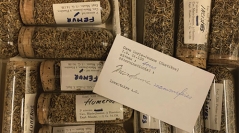

 Comptes Rendus Palevol
18 (7) - Pages 849-875
Comptes Rendus Palevol
18 (7) - Pages 849-875Archeological sites usually provide important information about the past distribution of small vertebrate fauna, and by extension about past terrestrial environments and climate in which human activities took place. In this context, Belgium has an interesting location in northwestern Europe between the fully studied zooarcheological records of Germany and England. We present here the revision of the late Pleistocene (Marine Isotope Stages 3 and 2) collection of the “Caverne Marie-Jeanne” (Hastière-Lavaux, Namur), studied by Jean-Claude Rage in the 1970s and the revision of the whole “indeterminate” small vertebrate materials from the “Caverne Marie-Jeanne” stored in the Royal Belgian Institute of Natural Sciences (RBINS) Quaternary collections in search of more herpetofaunal remains. It is now by far the largest late Pleistocene collection at RBINS with more than 20,500 recognized bones of amphibians and reptiles and covering the last 60,000 years. The faunal list comprises two urodeles (Lissotriton gr. L. vulgaris and Salamandra salamandra), four anurans (Bufo gr. B. bufo-spinosus, Epidalea calamita, Rana temporaria and Rana cf. R. arvalis), three lizards (Lacerta cf. L. agilis, Zootoca vivipara and Anguis gr. A. fragilis), and three snakes (Natrix gr. N. natrix, Coronella austriaca, and Vipera berus). This study represents the first fossil record in Belgium for L. gr. L. vulgaris , R. arvalis, Z. vivipara, N. gr. N. natrix and C. austriaca. As a whole, this assemblage suggests a patchy humid landscape under colder and dryer climatic conditions in comparison with present ones. This study also underlines the necessity of a primary separation in larger taxonomical categories by the specialist itself.
Herpetofauna, paleobiogeography, paleoecology, Late Pleistocene, Northwestern Europe